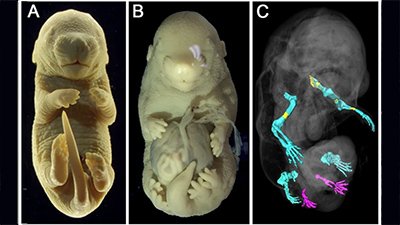
Finding Adam in the Genome: Part 2 of a Response to Chapter 2 (and Chapter 4) of Adam and the Genome
This article series has been slowly and carefully responding to the scientific claims in Adam and the Genome.1 In previous articles, we covered the claims of chapter one, and began an analysis of chapter two. The latter was the first chapter to explicitly deal with genetics, and it naturally led to a discussion of chapter four. In this post, we continue dealing with the specific scientific claims of chapter two.
Throughout this series, our approach has been driven by the practice of theistic evolutionists. They do not read our technical literature; hence, in the first several articles of this series, we republished a lay-level summary of this literature. Theistic evolutionists also think that we are liars. Therefore, they ignore creationist hypotheses from the outset of their studies. Consequently, when evolutionists make scientific claims, they effectively fit facts to conclusions. In our series thus far, we’ve discovered abundant support for this strong claim. In this article, we’ll continue to explore whether it is true.
The Inadequate Analogy of Language and Evolution
In our previous article, we began to dissect the analogies used by the author, Dennis Venema. The entirety of chapter two draws heavily on an analogy between the process of language change and the process of evolutionary change in species. We observed that Venema’s analogy runs into an insurmountable obstacle. While language analogies might explain some level of biological change, it cannot help evolution overcome its inability to explain the origin of biological systems with multiple, mutually interdependent parts (irreducibly complex systems, as per Michael Behe’s terminology).
To his credit, Venema acknowledges that his analogy has limitations (but not the limits that we identified via Behe’s insightful analyses). Venema states,
Every analogy has its weak points. In a language, every word has meaning, and words tend to be relatively short. In contrast, genes—our genetic word equivalents—can be hundreds, thousands, or even tens of thousands of DNA letters long.2
On this point, Venema is correct. But then he makes another statement.
Another surprising difference is that animal genomes have a lot of DNA letters that do not appear to have a specific function; they don’t really seem to be “words” but rather just filler. If there is a function associated with them, it seems that almost any string of letters will do.3
Venema doesn’t give any lengthy defense for this assertion. We’ll soon observe the challenge that he faces in making this claim.
Venema also asserts—without little scientific justification—that “languages change much more rapidly than genomes do.”4 This statement flies in the face of recent genetic data.5
Venema thinks that we can trace common ancestry among species in the same way that we can trace common ancestry among languages.
Nevertheless, despite Venema’s own admission of limitations, he thinks the parallels between language change and biological change force a very specific conclusion. Specifically, Venema thinks that we can trace common ancestry among species in the same way that we can trace common ancestry among languages. In other words, Venema thinks that the pattern of genetic differences is strong evidence in support of evolution.
In chapter two, Venema walks through several types of patterns, and gives examples for each. In this article, we’ll deal with just one pattern—and explore the others in subsequent posts.
The Evolutionary Hypothesis of Functional Redundancy
The first type of evolutionary pattern revolves around the concept of redundancy. Drawing upon his analogy to languages, Venema (correctly) identifies that many words can have alternate spellings, yet still carry the same meaning. Perhaps the most familiar example of this is the alternative British and American spellings for English words. Similarly, Venema claims that genetic “words”—genes—also can be spelled (with chemical letters) in a variety of ways, all without changing the function of these genes. In other words, Venema says that both languages and genetic codes contain a level of redundancy.
Applying these principles to the question of origins, Venema asks whether the genetic patterns among redundant genetic sequences fit the hypothesis of design. After all, if the Designer had many options to choose from when creating the genes in the first biological ancestors, why stick to just one type of gene spelling? Why not use a diversity of spellings, just for diversity’s sake? Alternatively, why not use the same design in every creature? If one function works, why not reuse it over and over again?
Venema makes his questions very specific with a particular type of gene—the gene for insulin. He claims that this gene has the same meaning in various species—that it performs the same function, namely, regulating glucose levels. For a subset of the chemical letters in the insulin gene, Venema then calculates the number of possible ways the letters could be arranged, while still communicating the same biological meaning. Because of genetic redundancy, Venema calculates the number of possible ways to be over 530,000. He thinks that, from a design perspective, the Designer of this insulin gene had an enormous number of options when he created it in these various creatures.
Yet what we observe today is a very limited subset of this incredible number of possibilities. This fact alone, in Venema’s mind, seems inconsistent with the design hypothesis. The gene spellings for insulin in various creatures are neither very diverse, nor exactly identical.
Furthermore, Venema thinks that the specific patterns harken very strongly to common ancestry. The actual number of differences in the spelling of insulin seems, to Venema, to fit a hypothesis of common ancestry. For example, the spelling of the human insulin gene most closely matches the spelling of insulin in the great apes, but less so the spelling of insulin in dogs and wolves. Venema sees this as consistent with the hypothesis that humans had a recent common ancestor with great apes—more recent than with dogs and wolves. Venema concludes,
This level of identity far exceeds what is needed for functional insulin, and strongly supports the hypothesis that humans share a common ancestral population with great apes. Indeed, the similarities between these sequences make English and West Frisian6 look like very distant relatives by comparison.7
Has Venema found strong evidence for common ancestry?
At first pass, the answer might seem to be “yes.” Venema’s claims about the redundancy of the genetic code are textbook science. I learned it myself in the university classroom.
The redundancy of the genetic code is true in only a limited scientific sense.
However, both Venema and evolutionists at universities have made a misstep. The redundancy of the genetic code is true in only a limited scientific sense. For the purpose of coding for molecules like proteins, the genetic code is functionally redundant. But the functions of the genetic code go beyond just coding for proteins.
Before considering what these functions might be, let’s make a basic observation—one that Venema himself acknowledges. The various spellings of the gene for insulin in various species match the classification of these species. However, the classification system was invented by Linnaeus long before anyone had access to genetic spellings. Linnaeus, therefore, used the anatomy and physiology of various species to classify them into an ordered hierarchy. The anatomy and physiology of species are the functional characteristics of each species—functions that go beyond just regulating glucose levels. In other words, without knowing anything else about the genetic spellings for insulin, the fact that genetics matches a functional system of classification should immediately suggest that these spellings might perform more functions than first meet the eye.
With respect to the real explanation for the insulin gene spellings, this first clue finds support in a second clue. Venema’s claims about the functional redundancy of the genetic code are actually a hypothesis that he misstates as fact. No one has experimentally explored all the possible functions for each of the insulin spellings. Technically, this makes Venema’s claims a form of pseudoscience. However, for our purposes, we’ll treat Venema’s claims as a testable prediction.
A third clue: I have already published a scientific model that makes testable predictions about genetic function.8 This model predicts that these insulin spellings are not so functionally redundant after all.
At this stage, we might stop and wait for experimental results to eventually trickle in. However, within the last five years, a number of surprising experimental results have been published.9 These results suggest additional functions for the genetic code. For example, while the genetic “word” insulin can be spelled in a variety of ways, the process of writing this word (i.e., translating the RNA code for this word into a protein sequence) inside the cell can happen slowly or quickly. It seems that the pace of this process has functional consequences inside the cell. In other words, recent experimental results are setting a trajectory that undermine Venema’s fundamental assumption—and contradict textbook science.
The claim that the genetic code is partially functionally redundant—and, therefore, evidence of common ancestry—is an evolutionary prediction that does not seem to be aligning too well with the experimental facts.
To be sure, many more experimental studies are needed. But this fact alone undermines Venema’s claim. He’s treating the functional redundancy of the genetic code as settled science—not as the tentative explanation for experiments in progress.
Why? Why does Venema confuse hypothesis with fact? Because, in his mind, and in the minds of so many evolutionists, evolution is not one of many hypotheses to be tested. It is the test of scientific hypotheses. Therefore, Venema filters facts through this conclusion. The concept of functional redundancy fits the evolutionary filter; therefore, Venema treated it as fact.
Footnotes
Dennis R. Venema and Scot McKnight. Adam and the Genome: Reading Scripture after Genetic Science. Grand Rapids, MI: Brazos Press, 2017.
Venema, 23–24.
Venema, 24.
Venema, 24.
N. T. Jeanson, “Recent, Functionally Diverse Origin for Mitochondrial Genes from ~2700 Metazoan Species,” Answers Research Journal 6 (2013): 467–501, https://answersingenesis.org/genetics/mitochondrial-dna/recent-functionally-diverse-origin-for-mitochondrial-genes-from-~2700-metazoan-species/.
West Frisian is a language spoken in the Netherlands. Venema discussed it earlier in his chapter.
Venema, 31.
N. T. Jeanson, “Recent, Functionally Diverse Origin for Mitochondrial Genes from ~2700 Metazoan Species.”
-
E.M. Novoa et al., “A Role for tRNA Modifications in Genome Structure and Codon Usage,” Cell 149, no. 1 (2012): 202–13, doi:10.1016/j.cell.2012.01.050.
M. Zhou et al., “Non-Optimal Codon Usage Affects Expression, Structure and Function of Clock Protein FRQ,” Nature 495, no. 7439 (2013): 111–115, doi:10.1038/nature11833.
Y. Xu et al., “Non-Optimal Codon Usage Is a Mechanism to Achieve Circadian Clock Conditionality,” Nature 495, no. 7439 (2013): 116–20, doi:10.1038/nature11942.
A.B. Stergachis et al., “Exonic Transcription Factor Binding Directs Codon Choice and Affects Protein Evolution,” Science 342, no. 6164 (2013): 1367–72, doi:10.1126/science.1243490.
H. Gingold et al., “A Dual Program for Translation Regulation in Cellular Proliferation and Differentiation,” Cell 158, no. 6 (2014): 1281–92, doi:10.1016/j.cell.2014.08.011.
V. Presnyak et al., “Codon Optimality Is a Major Determinant of mRNA Stability,” Cell 160, no. 6 (2015): 1111–24, doi:10.1016/j.cell.2015.02.029.
D. D. Nedialkova and S. A. Leidel, “Optimization of Codon Translation Rates via tRNA Modifications Maintains Proteome Integrity,” Cell 161, no. 7 (2015): 1606–18, doi:10.1016/j.cell.2015.05.022.
G. Boël et al., “Codon Influence on Protein Expression in E. coli Correlates with mRNA Levels,” Nature 529, no. 7586 (2016): 358–63, doi:10.1038/nature16509.
C. E. Gamble et al., “Adjacent Codons Act in Concert to Modulate Translation Efficiency in Yeast,” Cell 166, no. 3 (2016): 679–90, 10.1016/j.cell.2016.05.070.
A. Radhakrishnan et al., “The DEAD-Box Protein Dhh1p Couples mRNA Decay and Translation by Monitoring Codon Optimality,” Cell 167, no. 1 (2016): 122–132, doi:10.1016/j.cell.2016.08.053.
Recommended Resources

Answers in Genesis is an apologetics ministry, dedicated to helping Christians defend their faith and proclaim the good news of Jesus Christ.
- Customer Service 800.778.3390
- © 2024 Answers in Genesis






